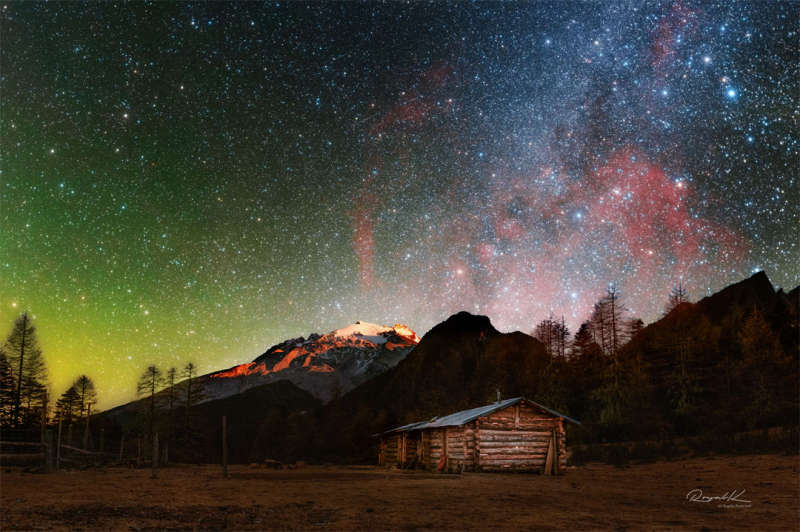
|
Credit & Copyright: Wang Jin
Explanation:
The Gum Nebula is so large and close it is actually
hard to see.
This interstellar expanse of glowing
hydrogen gas frequently evades
notice because it spans 35 degrees -- over 70 full Moons -- while much of it is quite
dim.
This featured spectacular 90-degree wide mosaic, however, was designed to be
both wide and deep enough to bring up
the Gum -- visible in red on the right.
The image was acquired late last year with both the
foreground -- including
Haba Snow Mountain -- and the background
-- including the
Milky Way's central band --
captured by the same camera
and from the same location in
Shangri-La,
Yunnan,
China.
The Gum Nebula is so close that we are only about
450 light-years
from the front edge, while about 1,500 light-years
from the back edge.
Named for a cosmic cloud hunter, Australian astronomer
Colin Stanley Gum
(1924-1960), the origin of this
complex
nebula is still being debated.
A leading theory for the origin of the
Gum Nebula is that
it is the remnant of a million year-old
supernova explosion,
while a competing theory holds that
the Gum is a
molecular cloud
shaped over eons by multiple supernovas and the outflowing
winds of several massive stars.
|
January February March April May June July August September October November December |
| ||||||||||||||||||||||||||||||||||||||||||||||||
NASA Web Site Statements, Warnings, and Disclaimers
NASA Official: Jay Norris. Specific rights apply.
A service of: LHEA at NASA / GSFC
& Michigan Tech. U.
Based on Astronomy Picture
Of the Day
Publications with keywords: supernova remnant
Publications with words: supernova remnant
See also:
- APOD: 2025 October 1 Á NGC 6960: The Witchs Broom Nebula
- APOD: 2025 June 9 Á Between Scylla and Charybdis: A Double Cosmic Discovery
- Supernova Remnant Cassiopeia A
- APOD: 2025 January 8 Á Supernova Remnants Big and Small
- APOD: 2024 September 18 Á The Mermaid Nebula Supernova Remnant
- APOD: 2024 April 16 Á Filaments of the Vela Supernova Remnant
- APOD: 2024 April 3 Á Unusual Nebula Pa 30
